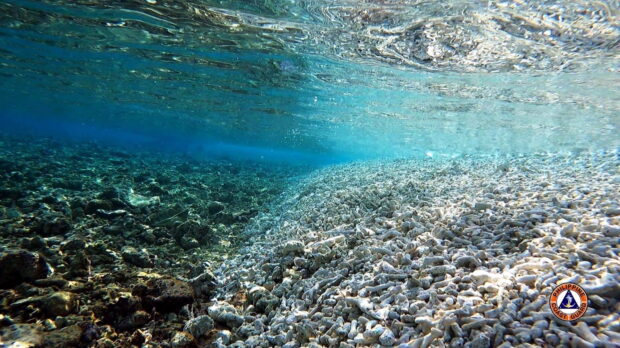
FILE PHOTO: A recent survey conducted by the Philippine Coast Guard in Escoda (Sabina) Shoal in the West Philippine Sea shows the destruction of the coral bed in the area, which has been blamed on the Chinese. —PHOTO COURTESY OF PCG
MANILA, Philippines — Coral and reef destruction took one of the spotlights during Thursday’s deliberation on the proposed P25.6-billion budget of the Department of Science and Technology (DOST) at the Senate.
In light of the reported destruction of corals in the West Philippine Sea – allegedly by Chinese vessels swarming within the Philippines’ exclusive economic zone, Senator Francis Tolentino raised the matter before DOST officials present in the hearing.
“Kung sakaling tuloy ang destruction ng corals, totoo bang mas malakas ang waves kapag may lindol [at] mas may posibilidad na magkaroon ng tsunami?” asked Tolentino, who presided over the hearing conducted by the Senate subcommittee on finance.
(If the destruction of corals continues, is it true that the waves are stronger when there is an earthquake [and] there is a greater possibility of a tsunami?)
READ: AFP sounds alarm: Rozul Reef’s corals completely wiped out
Philippine Institute for Volcanology and Seismology (Phivolcs) Director IV Teresito Bacolcol answered, saying corals have a “very minimal” effect on wave reduction and that mangroves may have a greater impact in helping reduce wave rates than corals.
But Tolentino pointed to a study, which he did not name, in proceeding to emphasize that the loss of reefs makes coastal communities susceptible to natural hazards like coastal erosion, flooding, and tsunami, among others.
“Healthy coral reefs act as natural buffers, reducing wave energy and protecting coastlines,” the senator even pointed out.
READ: DFA airs serious concern over reported reef, coral damage in West PH Sea
This prompted DOST Secretary Renato Solidum Jr. to reply, agreeing that the senator was “really correct.”
“Let me just give you a concrete example. If you noticed, several years ago, President Duterte stopped the operation at Boracay. Boracay was actually a disaster in the making because the corals were being destroyed by the algae,” the DOST chief explained.
“The algae would suffocate the corals, but corals actually prevent the wave erosion, and corals supply the sand to Boracay. The net effect is when there’s so much pollution, the corals die. There [has] been more than 20-meter erosion in Boracay because of the destruction of corals, so [that’s correct],” Solidum added.
Tolentino subsequently underscored “interconnected ecosystems” that the destruction of one part could spell disaster or danger to others such as people living in coastal communities.
READ: Coast guard surveys ‘deliberate’ reef damage
The DOST is asking Congress for a P25.6-billion budget in 2024, including P729.76 million funding for Phivolcs and P1.557 billion for the Philippine Atmospheric, Geophysical and Astronomical Services Administration (Pagasa).
Phivolcs and Pagasa are attached agencies of the DOST.
The Senate subcommittee on finance, which Tolentino chairs, on Thursday approved the DOST’s requested budget for 2024.
READ: Senate urged to probe China’s alleged harvesting of corals in Rozul Reef